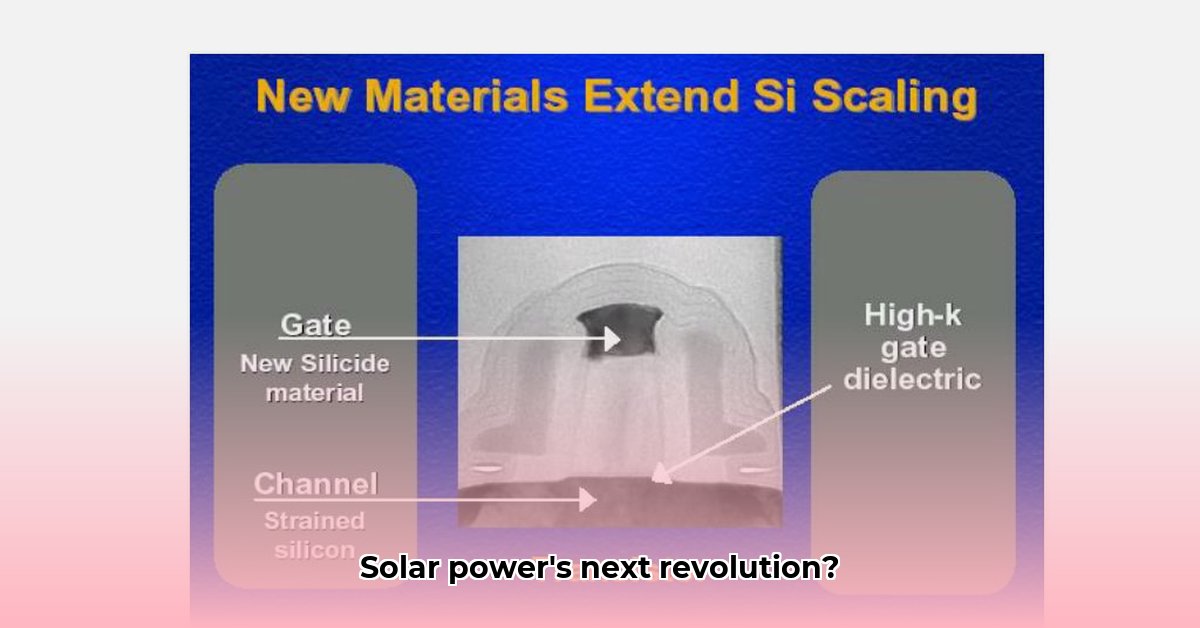AmberWave Systems is forging a path toward revolutionizing the solar energy and semiconductor sectors through innovative materials science. For more information on solar energy advancements, see this resource. This report examines their core technologies, potential market impact, and the challenges they face.
Ultra-Thin Silicon (UTSi): Redefining Solar Panel Design
AmberWave’s Ultra-Thin Silicon (UTSi) technology promises a paradigm shift in solar panel design. By significantly reducing the weight of solar panels while maintaining comparable efficiency, UTSi unlocks possibilities for widespread integration into diverse applications. Imagine solar panels seamlessly incorporated into building materials or flexible panels deployed in portable power solutions. AmberWave states that UTSi panels are up to 90% lighter than conventional panels, potentially reducing installation costs by as much as 30%.
The utilization of light weight panels can open doors for uses previously deemed impossible and greatly decrease set up costs. However, several critical questions arise:
- Long-Term Durability: How will UTSi panels withstand prolonged exposure to diverse and extreme weather conditions compared to traditional, heavier panels?
- Competitive Landscape: How will UTSi compete with established solar panel manufacturers who possess extensive distribution networks and economies of scale?
- Independent Validation: Can AmberWave demonstrate the long-term reliability and performance of UTSi through rigorous, independent testing and real-world deployments?
- Manufacturing Scalability: Can AmberWave scale up UTSi production to meet anticipated demand while maintaining quality and cost-effectiveness?
Strained Silicon: Enhancing Semiconductor Performance and Efficiency
Beyond its innovations in solar energy, AmberWave is also making significant strides in semiconductor technology through its strained silicon solutions. Strained silicon enhances electron mobility, leading to faster, more powerful, and more energy-efficient chips. As demand continues to surge for greater processing power and reduced energy consumption, AmberWave’s technology has the potential to become a critical enabler for next-generation electronic devices.
Key considerations for their strained silicon technology include:
- Commercial Viability: Can AmberWave manufacture strained silicon at a commercially competitive scale and price point?
- Manufacturing Yield: What are the expected manufacturing yields for strained silicon, and how will these yields impact overall production costs?
- Competitive Advantage: How does AmberWave’s strained silicon technology compare to competing solutions in terms of performance, cost, and ease of integration?
- Market Adoption: What strategies will AmberWave employ to encourage widespread adoption of its strained silicon technology among semiconductor manufacturers?
Addressing Information Asymmetry: Building Trust and Transparency
A significant challenge in evaluating AmberWave Systems is the limited availability of comprehensive, transparent data. The absence of detailed information on market share, financial performance, intellectual property portfolio, and independent performance benchmarks hinders a complete and objective assessment of the company’s potential.
Robust performance data, validated through independent testing, is essential for:
- Building Investor Confidence: Providing potential investors with the data they need to make informed decisions.
- Establishing Industry Credibility: Demonstrating the reliability and effectiveness of AmberWave’s technologies to potential customers and partners.
- Identifying Potential Challenges: Uncovering potential limitations or challenges early on in the development process.
Strategies for Navigating the Future: A Roadmap for Success
To ensure long-term success, AmberWave Systems and its stakeholders should prioritize the following strategies:
- Independent Verification & Validation: Conduct rigorous, independent testing of UTSi and strained silicon technologies to validate performance claims and identify potential limitations.
- Real-World Pilot Projects: Deploy pilot projects in diverse environments to generate real-world performance data and demonstrate long-term durability.
- Strategic Partnerships & Collaborations: Forge strategic partnerships with established industry players to gain access to distribution channels, manufacturing expertise, and financial resources.
- Secure Funding & Investment: Obtain sufficient financial backing to scale up production, expand research and development efforts, and effectively compete in the market.
For Potential Investors:
- Thorough Due Diligence: Conduct comprehensive due diligence to assess competitive landscape, market viability, and potential risks and rewards.
- Long-Term Investment Perspective: Adopt a long-term investment perspective, recognizing that disruptive technologies often require significant time to mature and achieve widespread adoption.
For Relevant Industries:
- Continuous Monitoring & Tracking: Continuously monitor and track AmberWave’s progress, as its technologies have the potential to significantly impact the future of these industries.
- Integration Assessment & Planning: Evaluate the potential for integrating AmberWave’s technologies into existing products and services, and develop appropriate integration strategies.
Risk Assessment: Identifying and Mitigating Potential Challenges
AmberWave faces several potential risks that could impact its ability to achieve its goals. The following risk assessment outlines key challenges, their potential impact, and mitigation strategies:
| Risk Factor | Likelihood | Impact | Mitigation Strategy |
|---|---|---|---|
| Low Market Acceptance of UTSi | Medium | High | Conduct targeted marketing campaigns to highlight the benefits of UTSi; focus on niche applications where UTSi offers a clear advantage; demonstrate compelling cost and performance advantages compared to traditional solar panels. |
| Production Scalability Challenges | Medium | High | Establish strategic partnerships with experienced manufacturers; implement a phased rollout of production capacity; meticulously optimize manufacturing processes to ensure high yields and consistent quality. |
| Intense Competition | High | Medium | Differentiate UTSi and strained silicon through unique features and superior performance; aggressively protect intellectual property through patents and trade secrets; establish strong brand recognition and customer loyalty. |
| Technology Integration Issues | High | Medium | Collaborate closely with industry leaders and potential customers to ensure seamless integration of AmberWave’s technologies; conduct rigorous testing and validation to identify and resolve integration challenges; provide comprehensive integration guidelines and technical support to facilitate adoption. |
| Fluctuations in Raw Material Costs | Medium | Medium | Secure long-term supply contracts with key raw material suppliers; explore alternative materials and manufacturing processes to reduce reliance on volatile commodities; implement hedging strategies to mitigate the impact of price fluctuations. |
| Changes in Government Regulations | Low | Medium | Actively monitor and engage with government agencies to stay informed of regulatory changes; advocate for policies that support the development and deployment of innovative energy and semiconductor technologies; maintain a flexible business model that can adapt to evolving regulatory requirements. |
The path ahead for AmberWave Systems is filled with both tremendous opportunity and significant challenges. Continued research, rigorous independent reviews, and strategic decision-making will be crucial in determining whether the company can successfully revolutionize the solar energy and semiconductor industries.
Assessing the Market Viability of AmberWave’s UTSi Solar Technology
Key Takeaways:
- UTSi technology offers the potential for efficient and lightweight solar energy generation.
- Strategic funding and partnerships indicate industry confidence in UTSi.
- Market viability depends upon achieving scaled manufacturing, competitive cost targets, and widespread adoption.
- Long-term success hinges on demonstrating superior performance and reliability.
UTSi: A Technological Deep Dive into Solar Disruption
AmberWave’s UTSi solar cells are designed to deliver high efficiency and significantly reduced weight, potentially enabling a wide range of applications that are not feasible with traditional solar panels.
Assessing Market Viability: A Balance of Promise and Peril
A comprehensive assessment of market viability requires careful consideration of several key factors:
- Efficiency and Cost: AmberWave’s ambitions for low-cost manufacturing must be balanced against the realities of scaling up production and achieving economies of scale.
- Adoption Challenges: Overcoming potential barriers to adoption among consumers and businesses will be critical for realizing the full market potential of UTSi.
- Strategic Partnerships: Establishing strong strategic partnerships with key players in the solar energy industry will be essential for accelerating manufacturing, distribution, and market entry.
- Practical Applications: Identifying and targeting specific niche markets and applications can provide initial pathways for UTSi adoption and market penetration.
Strategic Considerations for Stakeholders
- AmberWave: Focus on scaling up production, securing additional funding, and forging strategic partnerships to accelerate market entry and achieve widespread adoption.
- Investors: Monitor production progress, track market penetration, and carefully assess potential risks and rewards before making investment decisions.
- Governments: Continue to support research and development efforts and incentivize the adoption of innovative solar energy technologies such as UTSi.
- Consumers: Consider the long-term cost savings, aesthetic appeal, and environmental benefits of UTSi when making purchasing decisions related to solar energy.
Conclusion: Unlocking Disruptive Potential
AmberWave’s UTSi technology has the potential to disrupt the solar energy market by enabling new applications and reducing the cost of solar power. Realizing this potential will depend on overcoming manufacturing, cost, and market adoption challenges.
AmberWave UTSi Integration in Flexible Solar Roofing Systems
Key Takeaways:
- UTSi technology has the potential to improve the efficiency, weight, and cost of flexible solar roofing systems.
- Successful integration of UTSi into roofing systems depends on achieving cost-effective manufacturing and demonstrating long-term durability.
- Widespread market adoption will require competitive pricing and proven reliability.
- Strategic support and partnerships are crucial for accelerating market entry and achieving commercial success.
- Further research and development are needed to optimize UTSi performance and address potential integration challenges.
- Wind Turbine Fire: Questions About Safety Spark Debate - October 31, 2025
- Vertical Axis Wind Turbine Design: Improving Efficiency and Overcoming Limits - October 29, 2025
- Wind Turbine to Power Home: Nacelle Design Improvements Advance - October 26, 2025
















